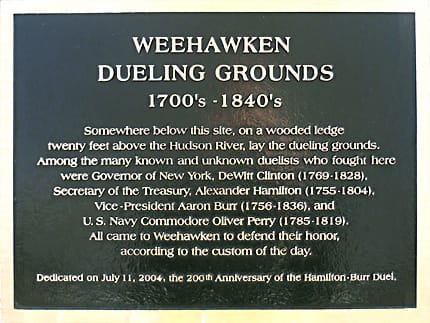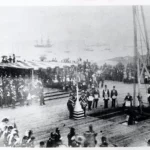A Stage for Honor and Tragedy
Nestled on the bluffs of the New Jersey Palisades, overlooking the majestic Hudson River, lies a site etched in American history: the Weehawken Dueling Grounds. This seemingly tranquil location, now transformed into a peaceful park, once served as a stage for honor-bound disputes settled with deadly consequences. From the early 18th century to the late 19th century, the secluded yet accessible nature of this site drew those seeking to resolve conflicts under a code of honor—a code that ultimately claimed the life of Founding Father Alexander Hamilton.
More Than Just the Hamilton-Burr Duel
While the duel between Alexander Hamilton and Aaron Burr in 1804 remains the most infamous event associated with Weehawken, this site witnessed at least 18 documented duels. For over a century, these grounds echoed with the crack of pistols as rivals, bound by a code of honor that valued reputation above all else, met at dawn to settle their differences. The secluded nature of the Palisades provided a veil of secrecy, allowing participants to circumvent laws prohibiting dueling while maintaining a veneer of discretion.
The Duel That Shook a Nation
The animosity between Alexander Hamilton, the nation’s first Secretary of the Treasury, and Aaron Burr, then-Vice President, had simmered for years, fueled by political disagreements and personal insults. On the morning of July 11, 1804, these two prominent figures met on the Weehawken Dueling Grounds. The exact chain of events remains shrouded in mystery and conflicting accounts, but the outcome remains a tragic turning point in American History. Mortally wounded by Burr’s shot, Hamilton was rowed back across the Hudson, dying the next day. The duel had a profound impact on the nation, leading to widespread condemnation of the practice and forever tarnishing Burr’s legacy.
Whispers of the Past: Exploring the Grounds Today
Today, the Weehawken Dueling Grounds offer a glimpse into a bygone era, a time when honor and reputation held a different weight. Hamilton Park, situated atop the Palisades, offers breathtaking views of the Manhattan skyline, a stark contrast to the deadly purpose the land once served. A bronze statue of Alexander Hamilton, erected in 1935, stands as a solemn reminder of the duel’s tragic outcome. Nearby, the “Weehawken Boulder,” a large rock believed to be where the wounded Hamilton was laid, adds a tangible connection to that fateful day.
Unearthing Hidden History
Beyond the Hamilton-Burr duel, the Weehawken Dueling Grounds offer a unique lens through which to examine a complex and often contradictory period in American history. Delving into the social and cultural context surrounding dueling reveals a society grappling with shifting values. Honor, once so closely tied to physical courage and reputation, gradually gave way to a more nuanced understanding as the tragic consequences of such a code became evident.
A Journey of Transformation
Weehawken’s story extends far beyond its days as a dueling ground. The town has transformed into a vibrant community, its history intertwined with the legacy of those fateful encounters. Visiting the Weehawken Dueling Grounds offers not just a history lesson but an opportunity to reflect on the evolution of a nation, a reminder of the enduring power of the past to shape the present.
- Unveiling the Enigma: Mansoureh Khojasteh Bagherzadeh’s Public Appearances & Private Life in Iran - July 18, 2025
- Unveiling the Mystery: Mansoureh Khojasteh Bagherzadeh’s Husband: A Rare Glimpse into a Private Life - July 18, 2025
- Unveiling Masoud Khamenei’s Mother: Power, Influence, and Iran’s Future - July 18, 2025
















